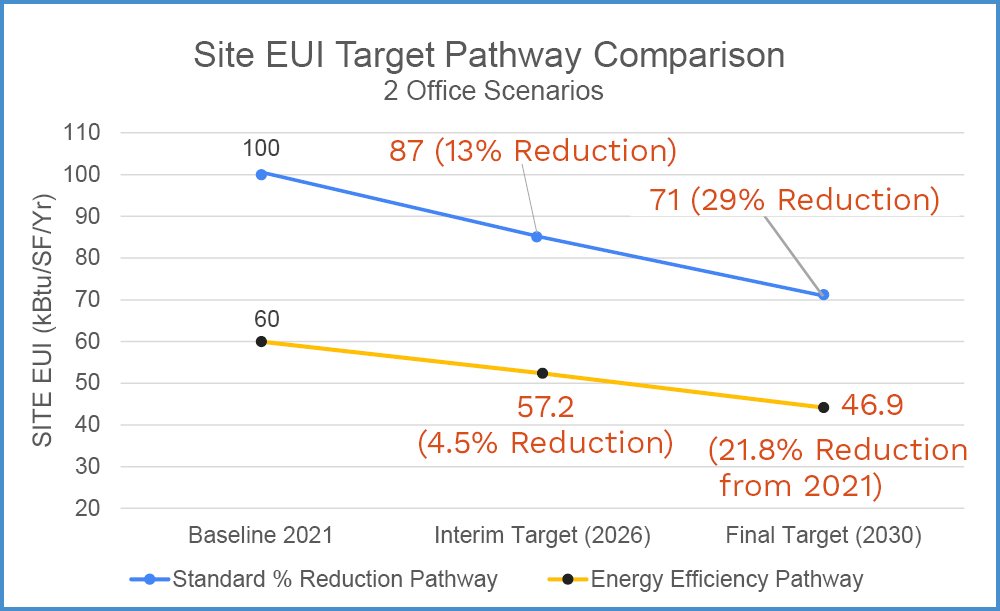The State of Colorado recently published a new website laying out its benchmarking and building performance standards program. As you can imagine, there’s a lot to navigate! We’re here to help guide you through what changes you need to make and where on the State website you can go to make them.
Some background: House Bill 21-1286 requires all buildings over 50,000 sq ft in the State of Colorado to comply with new building standards. The goal of the bill is to reduce statewide building GHG emissions, and the state-established performance standards program aims to provide a path toward a 7% emissions reduction by 2026 and 20% by 2030.
This article provides the guidance and links you need between now and August 1, 2024, in order to begin your journey toward compliance. Want to talk to a real person about your building, specifically? Email Energy & Sustainability Director Tom Poeling.
The Links You Need

Benchmarking reports, program resources, and communicate to CEO through their Help Desk on this website.

Access the Building Owner Portal to access benchmarking reports customized to your facilities.
3 Steps Toward Compliance
STEP 1
Now open!
Set up your Building Owner Portal Account.
- Through the portal, you can view reports and your compliance status, submit forms, and communicate with the State of Colorado Energy Office.
- Click here to set up your account.
STEP 2
Complete by August 1, 2024
Submit Annual Benchmarking Report to the State.
- Create or update your Energy Star Portfolio Manager Account with utility data. Click here to access the Portfolio Manager.
- Connect your ESPM account to the State’s database via Web Services. Click here to connect.
- Submit benchmarking data and pay annual fee of $100 per covered building each year. (Payment portal access coming soon.)
Potential penalty: If benchmarking reports are not submitted to the State by August 1, 2024, building owners will incur fees: $500 for the first occurrence, and $2,000 for each subsequent occurrence.
STEP 3
Complete by December 31, 2025
Comply with Building Performance Requirements.
Here’s an overview of Building Performance Standards.
- Identify your current Site Energy Use Intensity (EUI) through reports on the Building Owner Portal.
- Determine interim EUI/GHG target for 2026. See Appendix A of the State’s Technical Resource Guide, Property Type Site EUI and GHGI Targets.
- Select your Compliance Pathway, and click here to access the pathway selection form.
- Begin the process to reduce energy use to meet targets.
Future dates to note:
December 31, 2025: Perform energy audit to create compliance plan & file interim timeline or target adjustment.
June 1, 2027: Monthly interim BPS target penalties begin.
June 1, 2031: Monthly final BPS target penalties begin.
Colorado Compliance Pathways
1. Energy Efficiency Pathway
Reduce the building’s energy use through the implementation of energy efficiency measures and/or technologies. Achieve 2026 interim EUI target and 2023 final EUI target for your building type.
This is the default option. This option is represented by the yellow line in the below graphic, “Site EUI Target Pathway Comparison.
2. GHG Reduction Pathway
Reduce the building’s greenhouse gas emissions through replacing fossil fuel equipment with high-efficiency electric equipment, or through use or purchase of Renewable Energy Credits (RECs).
Select this option if your retrofit plan emphasizes electrification of heating systems and installation of renewable systems.
3. Standard % Reduction Pathway
Reduce the building’s energy or GHG emissions by the following percent reductions in each reporting period:
- 2026-2029: 13%
- 2030-2050: 29%
Select this option if your 2021 baseline EUI value is greater than 29% of your assigned EUI/GHG target. This option is represented by the blue line in the below graphic, “Site EUI Target Pathway Comparison.
Colorado EUI Targets
EUI baseline was set in 2021. Buildings must meet specified 2026 and 2030 EUI or GHG targets per property type (yellow line) or reach standard percent reduction of 13% in 2026 and 29% in 2030, whichever is least stringent (blue line).


Our teams are tracking the evolution of these regulations and are here to help. Reach out to Tom Poeling (email) to start the conversation about your facilities and how you can reach compliance with the new state BPS regulations.
To learn more about our approach to sustainability, visit U.S. Engineering’s Energy & Sustainability Services.